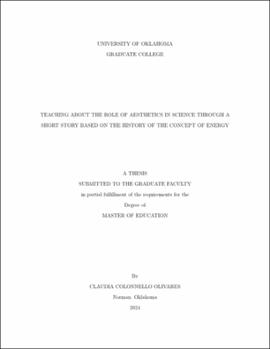| dc.description.abstract | The nature of science or, briefly, what science is and how it works, is an essential component of science education. However, it is not typically well understood by neither teachers nor students in K-12 settings. In particular, the complex role of aesthetics, i.e., of experiences of beauty, emotions, and taste, on how scientists engage with the practices and products of science is often misunderstood as being non-existent, or at least ideally so. This misconception has a negative effect on many students’ attitudes towards science, which, in turn, can negatively affect their learning of science.
In response to these concerns, the present study addresses the development and implementation, as well as the assessment of the effects, of an intervention that aimed at improving pre-service elementary teachers’ attitudes towards science by fostering an enhanced understanding of the role of aesthetics in science. The intervention was based on a short story concerned with episodes from the historical development of the concept of energy. It highlights ideas about the role of aesthetics in science through the events narrated in the story and through explicit statements and questions that foster personal reflection about these ideas. The discussion of this story formed the basis of an activity that was performed as part of one lesson in an introductory science methods course.
To assess the effects of the intervention on the participants’ attitudes towards science and understanding of the role of aesthetics in science, survey data was collected before and after the intervention and analyzed using a mixed-methods approach. Additionally, a small number of confirmatory follow-up interviews were performed and used to assess the accuracy of the analysis. The results show a positive effect of the intervention on the attitudes towards science of all the pre-service teachers that participated in the study. Moreover, the results also show a positive, though moderate, improvement in their understanding of the role of aesthetics in science. However, the improvement was not uniform among the three elements of aesthetics, being greatest for the role of emotions and smallest for the role of taste. | en_US |

